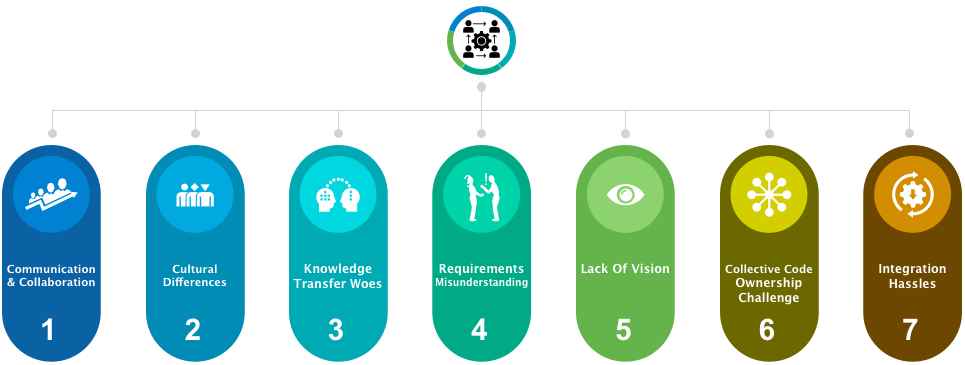August 1, 2018
7 Project management challenges in distributed development
In a distributed development environment, the teams involved in a project may be working from multiple business worksites or locations. Distributed development is imperative for the businesses, whether they are seeking cost benefits or trying to find highly specialized talent. With the agile development approach which demands a higher level of collaboration and a shorter delivery cycle, managing a project in a distributed development environment is more challenging.
Project management challenges in distributed development

1. Communication & Collaboration
The biggest advantage while working with a collocated team is that you get a chance to have a face to face conversation with your teammates. You get a chance to bond with your teammates and discuss any challenges, issues, and concerns with ease.
In a distributed development approach, the teams may be distributed over different continents and there may be a time zone difference with no overlapping work hours. There may be an instance when a team faces a bottleneck which requires the team on the other end to respond instantly. The delayed response from the other team can build resentment.
The biggest hurdle in an agile development approach working with distributed teams is to keep everyone on the same page as well as well as to improve collaboration among teams.
2. Cultural Differences
The cultural differences come into play when the distributed teams are spread across nations and continents. In some countries, it’s not natural for people to directly say no. While in some countries, it is perfectly acceptable to directly say no. There are certain non-verbal cues which have a specific meaning in some cultures. For example, a silent pause could mean disagreement. These cultural differences could create miscommunication and misunderstandings among remote team members.
3. Knowledge Transfer Woes
In a project with the development team, product owners, and users not collocated, knowledge transfer can be a big challenge. The product owner or product manager has the responsibility to enlighten the development team members on the product they are building.
The product owners interact with the users and they know what the key improvement areas of the product are. They have to communicate this to the development team. While working with a remote team, it is difficult for the product owner to educate the developers on user requirements. The product owners need to set up regular virtual meetings with the team as to hold knowledge sharing sessions. This can be difficult as the product owners and developers are working on strict deadlines.
4. Requirements Misunderstanding
In an agile development environment, there is a lack of proper documentation. The requirements evolve with the course of the project. With a distributed environment, it is difficult to clarify requirements for the Business Analysts and the development team. In case the Product Owner and Business Analysts are not collocated, there may be instances of misinterpretation of the requirements. A requirement which is misunderstood can lead to wasted efforts and a lot of rework.
5. Lack Of Vision
The remote development team tends to miss out on the bigger picture of the project. They are rather focused on their individual deliverables. The development’s team may lack the vision that the Product Owner wants to achieve through the project. Without a proper vision, the development team will fail to align their efforts with the business needs.
6. Collective Code Ownership Challenge
Collective code ownership implicates that the entire team owns a piece of code and no individual team members own a piece of code. Whenever code refactoring needs to be done, the entire team is involved in the process. Maintaining a collective code ownership in a distributed environment can be challenging. There is a need for appropriate Version Control Systems to maintain the code.
7. Integration Hassles
There is a greater risk when multiple locations are producing work that needs to be integrated. With distributed development, the integration may result in things falling apart. The remote teams need to practice continuous integration rigorously. The lack of a governance structure to maintain quality standards could lead to major bugs reaching the production phase of the project. Inconsistency in tools used at different locations will increase integration hassles further.
How ReQtest could help you be more successful in distributed development?
ReQtest is a cloud-based Application Lifecycle Management (ALM) tool which is specially designed for distributed teams. ReQtest provides anytime & anywhere access with the help of an internet connection and a browser. ReQtest is the preferred tool for distributed development as it offers:
- A suite of modules: requirement management, agile board, test management, bug tracking & reporting
- Centralized repository for all project related data
- “Agile board” for communication & collaboration among BA, testing & development team
- Traceability feature to trace links between Requirements, Test cases, & Bugs
- Support for Waterfall, Agile, & DevOps environment
- JIRA integration
- Data visualization to provide real-time insights
- Ease of use
Conclusion
Project management in a distributed environment is already a daunting task. The challenge is heightened further with agile methodology. To successfully combat the challenges posed by distributed development, a project management tool that facilitates collaboration and communication must be employed at all business worksites involved in a project.
Share article